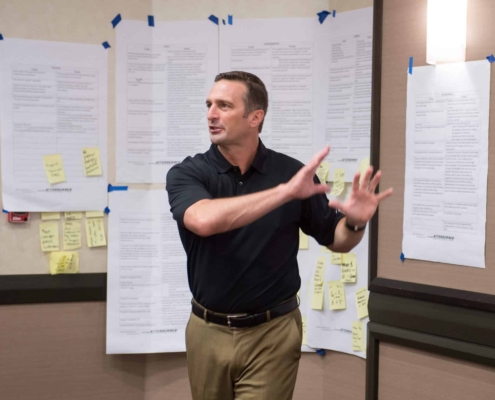 https://www.afterburner.com/wp-content/uploads/2024/09/leadership-symposium-afterburner.png
1050
1832
Nate Riggins
/wp-content/uploads/2024/07/Afterburner-Logo-Resize-Fullcolor-300x93.png
Nate Riggins2024-01-26 15:53:082024-10-23 10:53:39Decoding the 3 Crucial Leadership Situations
https://www.afterburner.com/wp-content/uploads/2024/09/leadership-symposium-afterburner.png
1050
1832
Nate Riggins
/wp-content/uploads/2024/07/Afterburner-Logo-Resize-Fullcolor-300x93.png
Nate Riggins2024-01-26 15:53:082024-10-23 10:53:39Decoding the 3 Crucial Leadership Situations
Between the idea
And the reality
Between the motion
And the act
Falls the Shadow
–T. S. Elliot, The Hollow Men
In a preceding article, I introduced the concept of a leadership development checklist and outlined six categories of actions to explore in greater detail in this and subsequent articles. This second in a series of seven articles will describe discreet actions leaders can take to build high-performing teams. It’s a tall order, but as I progress through this series I hope you will see that just such a checklist is possible in spite of the highly complex nature of leadership.
The checklist follows the L.O.C.K.E.D. on Teams℠ structure. I will treat the six categories of the leadership checklist in reverse order. This article addresses the “D” which stands for discipline.
Discipline is where the rubber meets the road for every leader. Without discipline, becoming more than a part-time, distracted leader will be challenging. Discipline is about focusing on the right things at the right time. It’s about doing what you must do if the organization you lead is to get where it is going. Discipline relates to the team’s ability to carry out the plan as it was planned; its adherence to an established execution rhythm℠; its ability to adapt to change by utilizing X-Gap meetings℠; and its capacity to resist disruptions and distractions. It is, first and foremost, doing what you and your team are supposed to do and agreed to do . . . even when you don’t feel like it. As the poet T. S. Elliot poignantly describes as a ‘shadow’ in The Hollow Men, the disconnect between what we know should be done and actually doing it, is a failure of discipline. Discipline is what connects thought and purpose to action. “Hesitation,” according to Jocko Willink, a retired Navy Seal Commander and author of Discipline Equals Freedom Field Manual, “is the enemy.”
Shining a bright light to disperse the shadow between thought and act – being disciplined – is much easier when you develop appropriate habits. The chasm of hesitation can be bridged. I’ve explored how habit can be a powerful positive force in teams and organizations in Corporate Leadership Development Challenges: Shaping Culture the Military Way. With apologies to Nike, discipline’s mantra should be ‘just do it!’
Build Your High-Performance Team
So, what are the checklist items to support disciplined teams? There are six things that leaders can do to improve discipline on their teams, daily. They are:
Prioritize: Objective – Team – Self
There is a three-part hierarchy that every leader must keep straight when they are doing the business of leading. The objective of the team or organization comes first. After that, the welfare and development of the team members follows closely on the heels of the mission. In many situations the team may even come before the objective. But, what is certain is that the interests of the leader come last. That doesn’t mean that the leaders interests and needs aren’t important, just that they come after the interests of the mission and the team. As a leader, put yourself last.
Actions: At the end of the day, debrief yourself. Did you lead the team closer to the objective? Did you take care of the team? Did you put your own interests before either?
Assess Risk
Good leaders take time to make good decisions. They pause to consider the risks of a course of action. For leaders that lead collaborative, team planning through the Flawless Execution™ 6-step planning process perform a basic risk assessment by identifying threats, resources, and evaluating lessons learned before making a formal go/no go decision. Better leaders use a more robust risk assessment model that we teach as an added step when specific hazards are identified in the planning process. When Flawless Execution is a process of record for a team, the discipline to make good risk assessment becomes positively habitual.
Actions: Use the 6-step planning process. When you identify hazards, use the Flawless Execution risk assessment protocol to guide good decisions.
Focus on Objective – Align
Know why you and your team are engaged in some activity. Why is it important? How does the activity support a strategic intent? How does the activity support achieving your vision of the future, what we call a High-Definition Destination (HDD)? Know how every activity aligns to the organization’s purpose and vision (organizational identity and HDD). If you don’t have clear purpose and vision, staying focused and executing with discipline becomes much more difficult.
Actions: Communicate the organizational identity, HDD, and strategy as-a-whole or in part every day. Start formal Flawless Execution processes like briefs and X-Gap meetings with a summary of these ideas to create clear alignment and focus.
Identify Task Saturation
All the discipline in the world can’t buy more time. You and your team can only do so much. Task saturation, having too much to do and too little time or resources to do it, can disengage team members, cause misaligned execution, and precipitate a host of other ineffective or down-right disastrous results.
Actions: At the beginning and/or end of the day, ask yourself, who on my team is task saturated and how might I/we help them? The act of assisting team-mates with task saturation is known as mutual support. Leaders that display mutual support ‘walk the walk’ and inspire others on the team to do the same. Use the 6-step planning process so that the potential for task saturation is identified up front and steps can be taken to mitigate its effects.
Develop Cross-Checks
Do you and your team know what the top priority is and what other things are highly important? If not, how do you and the members of your team decide what to do when a crisis arises? How will you make your daily ‘to do’ list? We teach the value of cross-checks in Flawless Execution, a hub-and-spoke arrangement of important things surrounding the single most important thing. Can each member of your team describe that cross-check? Roles on a team vary. So, each member of your team might need a different cross-check What’s the process for checking every item on that cross-check daily to make sure important things don’t get missed?
Actions: Build a cross check for yourself. Have each member of your team build a cross check for themselves. Post it on the wall and check it . . . every . . . single . . . day.
Task Shed
When Task Saturation strikes, what will you stop doing? You know you have to do the things that support the cross-check you’ve built, but what about all the other things you do regularly. Do you have a clear understanding of how important (or unimportant) all those various tasks and activities are so that you can suspend one or more of those things when time runs out?
Actions: Build a task-shedding protocol. Go through your regular tasks and activities and put them all into four categories – must do’s, should do’s, good to do’s, don’t do’s. When time becomes scarce, stop doing the don’t do’s. When task saturation hits with a fury, suspend the good to do’s temporarily. Keep your list updated.
That’s it, just six things to check daily or, at least, weekly to improve an essential element of high-performing teams, discipline. In the next article in this series, I will address the ‘E’ for ‘experience’ in the L.O.C.K.E.D on Teams model.
Share This Post
More Like This
 https://www.afterburner.com/wp-content/uploads/2024/09/leadership-symposium-afterburner.png
1050
1832
Nate Riggins
/wp-content/uploads/2024/07/Afterburner-Logo-Resize-Fullcolor-300x93.png
Nate Riggins2024-01-26 15:53:082024-10-23 10:53:39Decoding the 3 Crucial Leadership Situations
https://www.afterburner.com/wp-content/uploads/2024/09/leadership-symposium-afterburner.png
1050
1832
Nate Riggins
/wp-content/uploads/2024/07/Afterburner-Logo-Resize-Fullcolor-300x93.png
Nate Riggins2024-01-26 15:53:082024-10-23 10:53:39Decoding the 3 Crucial Leadership Situations https://www.afterburner.com/wp-content/uploads/2024/09/thethreebiggest-1.jpeg
931
1400
Nate Riggins
/wp-content/uploads/2024/07/Afterburner-Logo-Resize-Fullcolor-300x93.png
Nate Riggins2024-01-03 15:04:522024-10-23 10:53:40The Three Biggest Obstacles to Building Trust as a Leader Today
https://www.afterburner.com/wp-content/uploads/2024/09/thethreebiggest-1.jpeg
931
1400
Nate Riggins
/wp-content/uploads/2024/07/Afterburner-Logo-Resize-Fullcolor-300x93.png
Nate Riggins2024-01-03 15:04:522024-10-23 10:53:40The Three Biggest Obstacles to Building Trust as a Leader Today https://www.afterburner.com/wp-content/uploads/2024/09/creating-a-strategy-1.jpeg
664
1000
Nate Riggins
/wp-content/uploads/2024/07/Afterburner-Logo-Resize-Fullcolor-300x93.png
Nate Riggins2024-01-03 08:00:192024-10-23 10:53:404 Questions You Have to Ask When Creating a Strategy
https://www.afterburner.com/wp-content/uploads/2024/09/creating-a-strategy-1.jpeg
664
1000
Nate Riggins
/wp-content/uploads/2024/07/Afterburner-Logo-Resize-Fullcolor-300x93.png
Nate Riggins2024-01-03 08:00:192024-10-23 10:53:404 Questions You Have to Ask When Creating a Strategy https://www.afterburner.com/wp-content/uploads/2024/09/CVMV_0008.jpg
1547
2100
Nate Riggins
/wp-content/uploads/2024/07/Afterburner-Logo-Resize-Fullcolor-300x93.png
Nate Riggins2022-11-10 15:37:382024-10-23 10:53:435 Leadership Skills to Get Your Revenue Engine Roaring in Q4
https://www.afterburner.com/wp-content/uploads/2024/09/CVMV_0008.jpg
1547
2100
Nate Riggins
/wp-content/uploads/2024/07/Afterburner-Logo-Resize-Fullcolor-300x93.png
Nate Riggins2022-11-10 15:37:382024-10-23 10:53:435 Leadership Skills to Get Your Revenue Engine Roaring in Q4
A Word from Murph: Right Now, Leadership in Business Means Going Back to Basics
Inspiration, Leadership, Leadership Development https://www.afterburner.com/wp-content/uploads/2024/09/AdobeStock_198086711-1.jpeg
1265
2048
Nate Riggins
/wp-content/uploads/2024/07/Afterburner-Logo-Resize-Fullcolor-300x93.png
Nate Riggins2020-03-30 09:00:352024-10-23 10:53:457 Leadership Tips to Motivate Your Remote Employees
https://www.afterburner.com/wp-content/uploads/2024/09/AdobeStock_198086711-1.jpeg
1265
2048
Nate Riggins
/wp-content/uploads/2024/07/Afterburner-Logo-Resize-Fullcolor-300x93.png
Nate Riggins2020-03-30 09:00:352024-10-23 10:53:457 Leadership Tips to Motivate Your Remote Employees https://www.afterburner.com/wp-content/uploads/2024/09/woman-showing-how-to-improve-your-situational-awareness-with-map-in-background-1.png
667
1000
Nate Riggins
/wp-content/uploads/2024/07/Afterburner-Logo-Resize-Fullcolor-300x93.png
Nate Riggins2020-03-22 07:00:122024-10-23 10:53:453 Ways to Improve Your Situational Awareness
https://www.afterburner.com/wp-content/uploads/2024/09/woman-showing-how-to-improve-your-situational-awareness-with-map-in-background-1.png
667
1000
Nate Riggins
/wp-content/uploads/2024/07/Afterburner-Logo-Resize-Fullcolor-300x93.png
Nate Riggins2020-03-22 07:00:122024-10-23 10:53:453 Ways to Improve Your Situational Awareness https://www.afterburner.com/wp-content/uploads/2024/09/team-sitting-in-a-meeting-listening-to-how-to-cope-with-task-saturation-1.png
439
1000
Nate Riggins
/wp-content/uploads/2024/07/Afterburner-Logo-Resize-Fullcolor-300x93.png
Nate Riggins2020-02-14 09:00:522024-10-23 10:53:45Identifying your Task Saturation Coping Mechanisms
https://www.afterburner.com/wp-content/uploads/2024/09/team-sitting-in-a-meeting-listening-to-how-to-cope-with-task-saturation-1.png
439
1000
Nate Riggins
/wp-content/uploads/2024/07/Afterburner-Logo-Resize-Fullcolor-300x93.png
Nate Riggins2020-02-14 09:00:522024-10-23 10:53:45Identifying your Task Saturation Coping Mechanisms https://www.afterburner.com/wp-content/uploads/2024/09/Men-writing-in-notebooks-to-help-eliminate-task-saturation-1.png
511
1000
Nate Riggins
/wp-content/uploads/2024/07/Afterburner-Logo-Resize-Fullcolor-300x93.png
Nate Riggins2020-02-05 09:00:582024-10-23 10:53:453 Simple Ways to Eliminate Task Saturation
https://www.afterburner.com/wp-content/uploads/2024/09/Men-writing-in-notebooks-to-help-eliminate-task-saturation-1.png
511
1000
Nate Riggins
/wp-content/uploads/2024/07/Afterburner-Logo-Resize-Fullcolor-300x93.png
Nate Riggins2020-02-05 09:00:582024-10-23 10:53:453 Simple Ways to Eliminate Task SaturationAbout Us
Building Strong Teams Through the Guidance of Fighter Pilot Keynote Speakers.

